Novel (Phenothiazinyl)Vinyl-Pyridinium Dyes and Their Potential Applications as Cellular Staining Agents
Abstract
:1. Introduction
2. Results and Discussion
2.1. Synthesis of PVP
2.2. X-ray Crystallographic Data
2.3. Optical Properties
2.4. Staining Investigation on B16-F10 Melanoma Cells
2.4.1. Cell Viability
2.4.2. Fluorescence Imaging
3. Experimental Section
3.1. Materials and Methods
3.2. Synthesis
3.3. X-ray Diffraction
3.4. Fluorescence Measurements
3.4.1. One-Photon Excited Fluorescence on Solid Samples
3.4.2. Fluorescence Quantum Yield
3.5. Cell Culture and Staining Protocol
3.6. Viability Assay
3.7. Fluorescence Imaging
3.8. Lipophilicity Protocol
- (1)
- Solvent preparation (water saturated with octanol and octanol saturated with water): potassium phosphate aq buffer (0.1 M pH 7.0) and an equal volume of 1-octanol were agitated to allow saturation, then left to separate overnight.
- (2)
- Preparation of dye stock solution: 100 μg / mL in DMSO.
- (3)
- A total of 150 μL of dye stock solution was added to 1425 μL of water (Vw) and the absorbance of this initial aqueous solution was measured (A).
- (4)
- To the aqueous solution with the dye 1425 μL of 1-octanol (V0) was added.
- (5)
- The sample was stirred for 2 h, then centrifuged (3500 rpm, 10 min) to separate the phases.
- (6)
- The absorbance of the separate aqueous solution (A’) was measured.
4. Conclusions
Supplementary Materials
Author Contributions
Funding
Institutional Review Board Statement
Informed Consent Statement
Data Availability Statement
Conflicts of Interest
References
- Pandith, A.; Guralamatta, R.; Siddappa, Y.; Seo, J. Recent Developments in Novel Blue/Green/Red/NIR Small Fluorescent Probes for in Cellulo Tracking of RNA/DNA G-quadruplexes. J. Photochem. Photobiol. C 2019, 40, 81–116. [Google Scholar] [CrossRef]
- Choi, P.; Noguchi, K.; Ishiyama, M.; Denny, W.A.; Jose, J. A Mitochondria-selective Near-infrared-emitting Fluorescent Dye for Cellular Imaging Studies. Bioorg. Med. Chem. Lett. 2018, 28, 2013–2017. [Google Scholar] [CrossRef] [PubMed]
- Braun, A.B.; Wehl, I.; Koelmel, D.K.; Schepers, U.; Braese, S. New Polyfluorinated Cyanine Dyes for Selective NIR Staining of Mitochondria. Chem. Eur. J. 2019, 25, 7998–8002. [Google Scholar] [CrossRef] [PubMed]
- Abeywickrama, C.S.; Bertman, K.A.; Pang, Y. From Nucleus to Mitochondria to Lysosome Selectivity Switching in a Cyanine Probe: The Phenolic to Methoxy Substituent Conversion Affects Probe’s Selectivity. Bioorg. Chem. 2020, 99, 103848. [Google Scholar] [CrossRef]
- Talianova, V.; Břiza, T.; Krčova, L.; Dolensky, B.; Kralova, J.; Martasek, P.; Kral, V.; Havlik, M. Coumarin Troger’s Base Derivatives with Cyanine Substitution as Selective and Sensitive Fluorescent Lysosomal Probes. Bioorg. Chem. 2020, 94, 103447. [Google Scholar] [CrossRef]
- Corona-Lopez, M.M.; Jimenez-Perez, V.M.; Chan-Navarro, R.; Ibarra-Rodríguez, M.; Dias, H.V.R.; Chavez-Reyes, A.; Munoz-Flores, B.M. Synthesis, Characterization, Photophysical Properties of New Fluorescent Boron Schiff Bases (BOSCHIBAs) and Their Application as Cytoplasm Staining Dyes in vitro. J. Organomet. Chem. 2017, 852, 64–73. [Google Scholar] [CrossRef]
- Di Maria, F.; Palama, I.E.; Baroncini, M.; Barbieri, A.; Bongini, A.; Bizzarri, R.; Giglid, G.; Barbarella, G. Live Cell Cytoplasm Staining and Selective Labeling of Intracellular Proteins by Non-toxic Cell-permeant Thiophene Fluorophores. Org. Biomol. Chem. 2014, 12, 1603–1610. [Google Scholar] [CrossRef] [PubMed]
- How, S.C.; Hsin, A.; Chen, G.Y.; Hsu, W.T.; Yang, S.M.; Chou, W.L.; Chou, S.H.; Wang, S.S. Exploring the Influence of Brilliant Blue G on Amyloid Fibril Formation of Lysozyme. Int. J. Biol. Macromol. 2019, 138, 37–48. [Google Scholar] [CrossRef] [PubMed]
- Udayan, S.; Sherin, D.R.; Vijaykumar, S.; Manojkumar, T.K.; Nampooria, V.P.N.; Sheenu, T. Exploring the LDS 821 Dye as a Potential NIR Probe for the Two Photon Imaging of Amyloid Fibrils. Biomater. Sci. 2020, 8, 6082–6092. [Google Scholar] [CrossRef]
- Collot, M.; Boutant, E.; Fam, K.T.; Danglot, L.; Klymchenko, A.S. Molecular Tuning of Styryl Dyes Leads to Versatile and Efficient Plasma Membrane Probes for Cell and Tissue Imaging. Bioconjug. Chem. 2020, 31, 875–883. [Google Scholar] [CrossRef] [PubMed]
- Gaina, L.; Torje, I.; Gal, E.; Lupan, A.; Bischin, C.; Silaghi-Dumitrescu, R.; Damian, G.; Lönnecke, P.; Cristea, C.; Silaghi-Dumitrescu, L. Microwave Assisted Synthesis, Photophysical and Redox Properties of Phenothiazinyl-vinyl-pyridinium dyes. Dyes Pigments 2014, 102, 315–325. [Google Scholar] [CrossRef]
- Ghosh, S.; Chopra, P.; Wategaonkar, S. C–H⋯S Interaction Exhibits all the Characteristics o of Conventional Hydrogen Bonds. Phys. Chem. Chem. Phys. 2020, 22, 17482–17493. [Google Scholar] [CrossRef]
- Tatikolov, A.S. Polymethine Dyes as Spectral-fluorescent Probes for Biomacromolecules. J. Photochem. Photobiol. C 2012, 13, 55–90. [Google Scholar] [CrossRef]
- SPARTAN’06; Wavefunction, Inc.: Irvine, CA, USA, 2013.
- Becke, A.D. Density-functional Thermochemistry III. The Role of Exact Exchange. Chem. Phys. 1993, 98, 5648–5652. [Google Scholar] [CrossRef] [Green Version]
- Stephens, P.J.; Devlin, J.; Chabulowski, C.F.; Frisch, M.J. Ab Initio Calculation of Vibrational Absorption and Circular Dichroism Spectra Using Density Functional Force Fields. J. Phys. Chem. 1994, 98, 11623–11627. [Google Scholar] [CrossRef]
- Lee, C.; Yang, W.; Parr, R.G. Development of the Colle–Salvetti Correlation Energy Formula into a Functional of the Electron Density. Phys. Rev. 1988, B37, 785–789. [Google Scholar] [CrossRef] [Green Version]
- Denk, W.; Strickler, J.H.; Webb, W.W. Two-photon Laser Scanning Fluorescencemicroscopy. Science 1990, 248, 73–76. [Google Scholar] [CrossRef] [Green Version]
- Iqbal, Z.; Wu, Q.W.; Zhang, H.; Hua, P.; Fang, X.; Kuang, D.; Wang, L.; Meier, H.; Cao, D. Impact of Hydroxy and Octyloxy Substituents of Phenothiazine Based Dyes on the Photovoltaic Performance. Dyes Pigments 2013, 99, 299–307. [Google Scholar] [CrossRef]
- CrysAlis P.R.O.; Rigaku Oxford Diffraction: Yarnton, UK, 2015.
- Sheldrick, G.M. A Short History of SHELX. Acta. Cryst. 2008, A64, 112–122. [Google Scholar] [CrossRef] [Green Version]
- Sheldrick, G.M. Crystal Structure Refinement with SHELXL. Acta. Cryst. 2015, C71, 3–8. [Google Scholar] [CrossRef]
- Dolomanov, O.V.; Bourhis, L.J.; Gildea, R.J.; Howard, J.A.K.; Puschmann, H. OLEX2: A Complete Structure Solution, Refinement and Analysis Program. J. Appl. Cryst. 2009, 42, 339–341. [Google Scholar] [CrossRef]
- Macrae, C.F.; Bruno, I.J.; Chisholm, J.A.; Edgington, P.R.; McCabe, P.; Pidcock, E.; Rodriguez-Monge, L.; Taylor, R.J.; Van de Streek, J.; Woo, P.A. Mercury CSD 2.0—New Features for the Visualization and Investigation of Crystal Structures. J. Appl. Cryst. 2008, 41, 466–470. [Google Scholar] [CrossRef]
- Brem, B.; Gal, E.; Gaina, L.; Cristea, C.; Gabudean, A.M.; Astilean, S.; Silaghi-Dumitrescu, L. Metallo Complexes of Meso-phenothiazinylporphyrins: Synthesis, Linear and Nonlinear Optical Properties. Dyes Pigments 2015, 123, 386–395. [Google Scholar] [CrossRef]
- Würth, C.; Grabolle, M.; Pauli, J.; Spieles, M.; Resch-Genger, U. Relative and Absolute Determination of Fluorescence Quantum Yields of Transparent Samples. Nat. Protoc. 2013, 8, 1535–1550. [Google Scholar] [CrossRef] [PubMed]
- Myers, J. Simplified Forms of the Myers-London Model for Intermolecular Forces in Liquids. J. Phys. Chem. 1980, 84, 1871–1872. [Google Scholar] [CrossRef]
- Suarasan, S.; Craciun, A.M.; Licarete, E.; Focsan, M.; Magyari, K.; Astilean, S. Intracellular Dynamic Disentangling of Doxorubicin Release from Luminescent Nanogold Carriers by Fluorescence Lifetime Imaging Microscopy (FLIM) Under Two-photon Excitation. ACS Appl. Mater. Interfaces 2019, 11, 7812–7822. [Google Scholar] [CrossRef]
- Pooler, J.P.; Valenzeno, D.P. Physicochemical Determinants of the Sensitizing Effectiveness for Photooxidation of Nerve Membranes by Fluorescein Derivatives. Photochem. Photobiol. 1979, 30, 491–498. [Google Scholar] [CrossRef] [PubMed]
- Chao-Shou, C.; Shiang-Tai, L. Prediction of pH Effect on the Octanol–Water Partition Coefficient of Ionizable Pharmaceuticals. Ind. Eng. Chem. Res. 2016, 55, 9284–9294. [Google Scholar] [CrossRef]
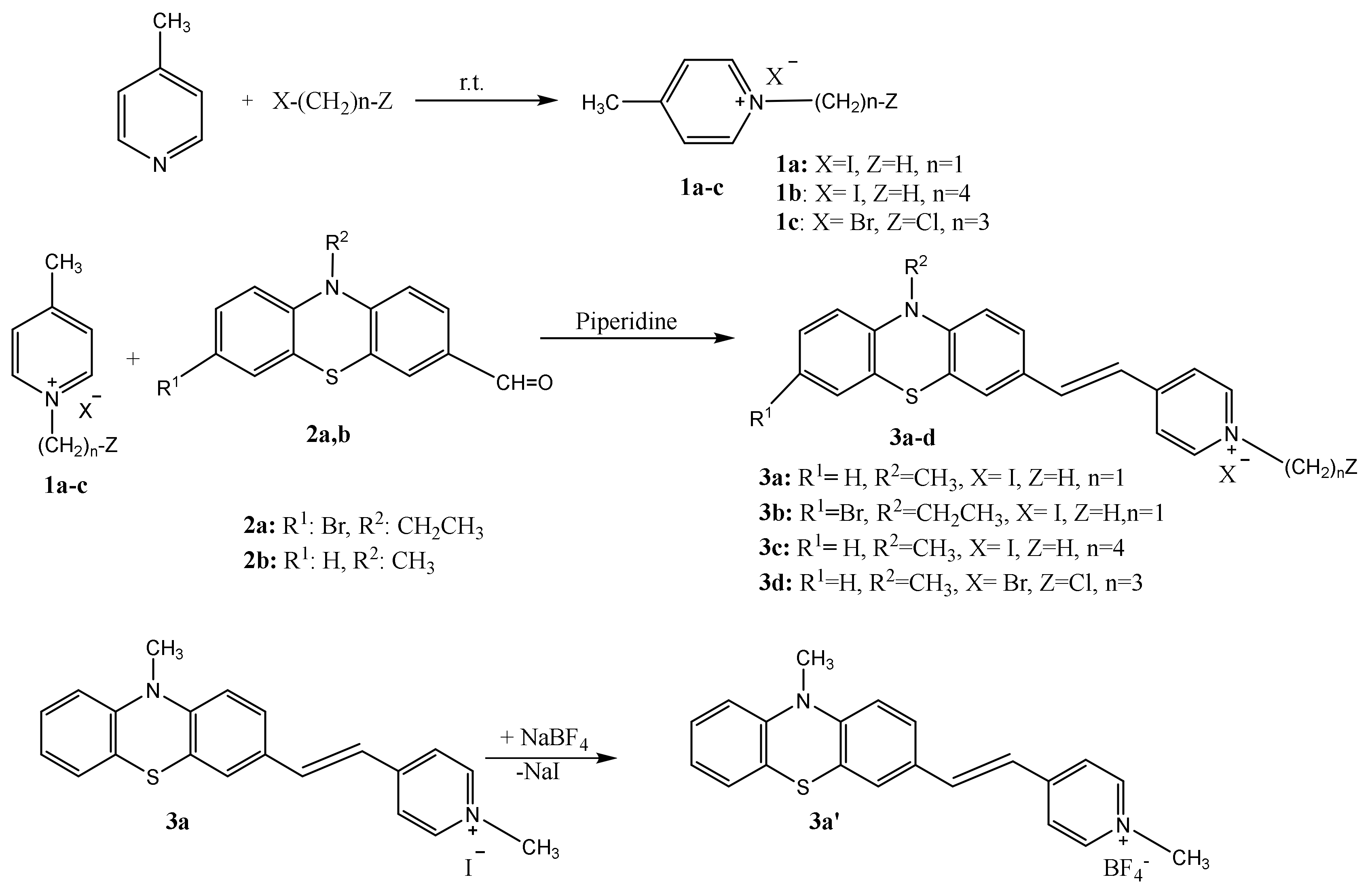
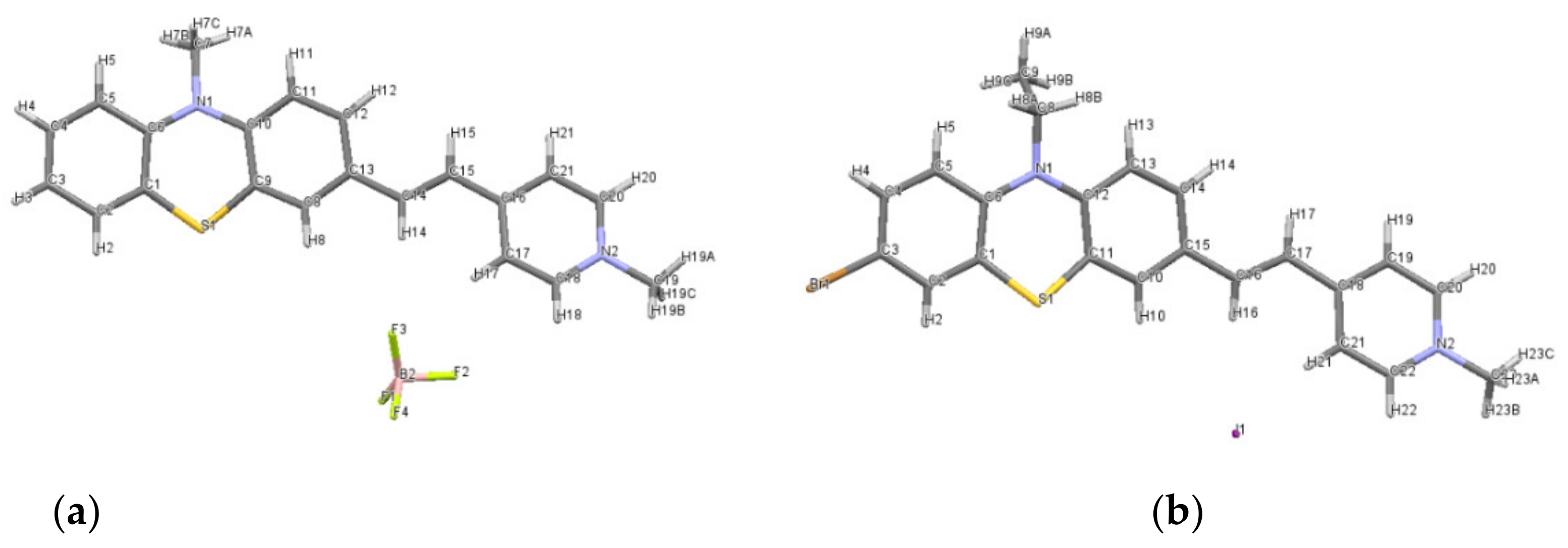
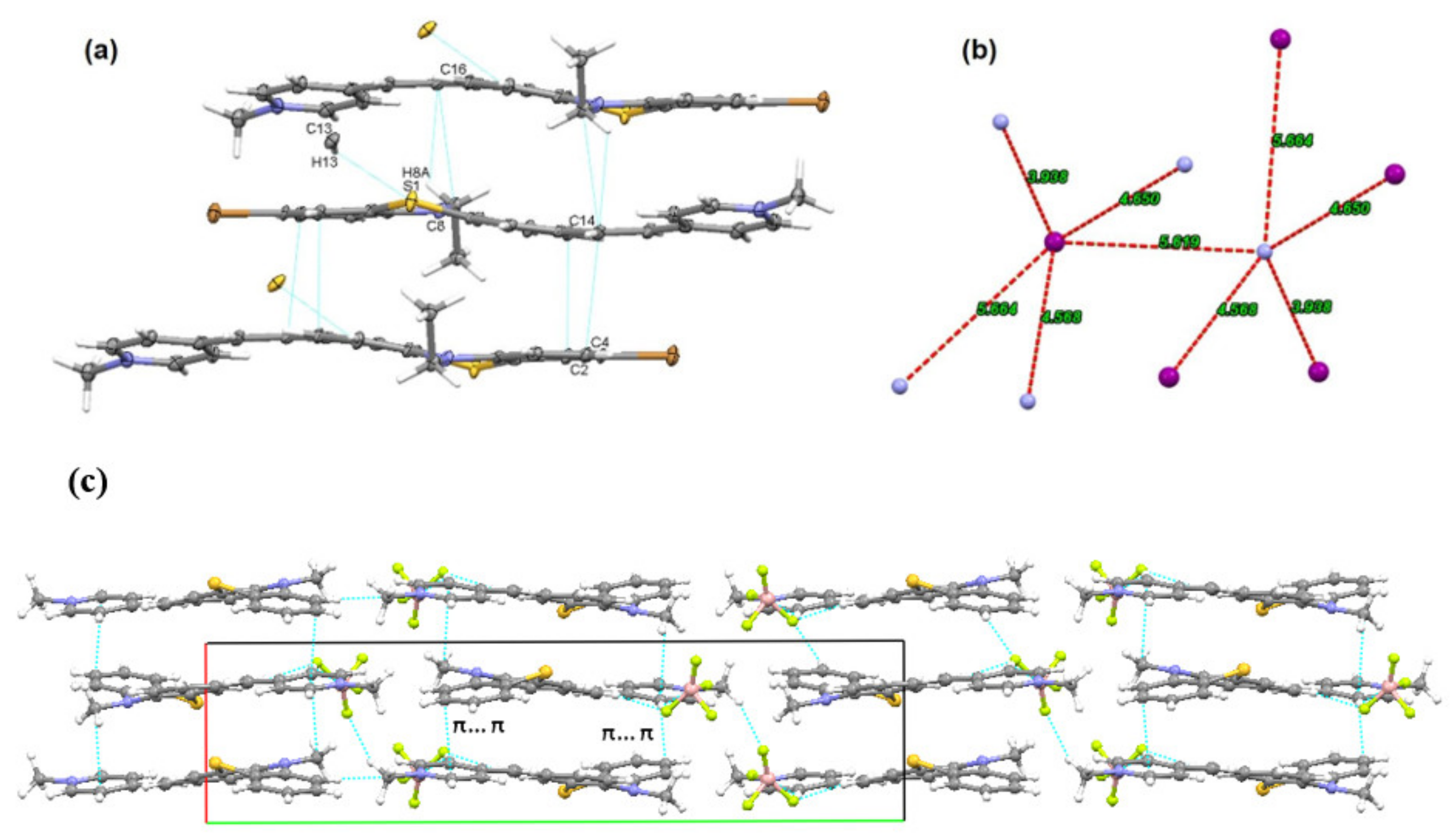
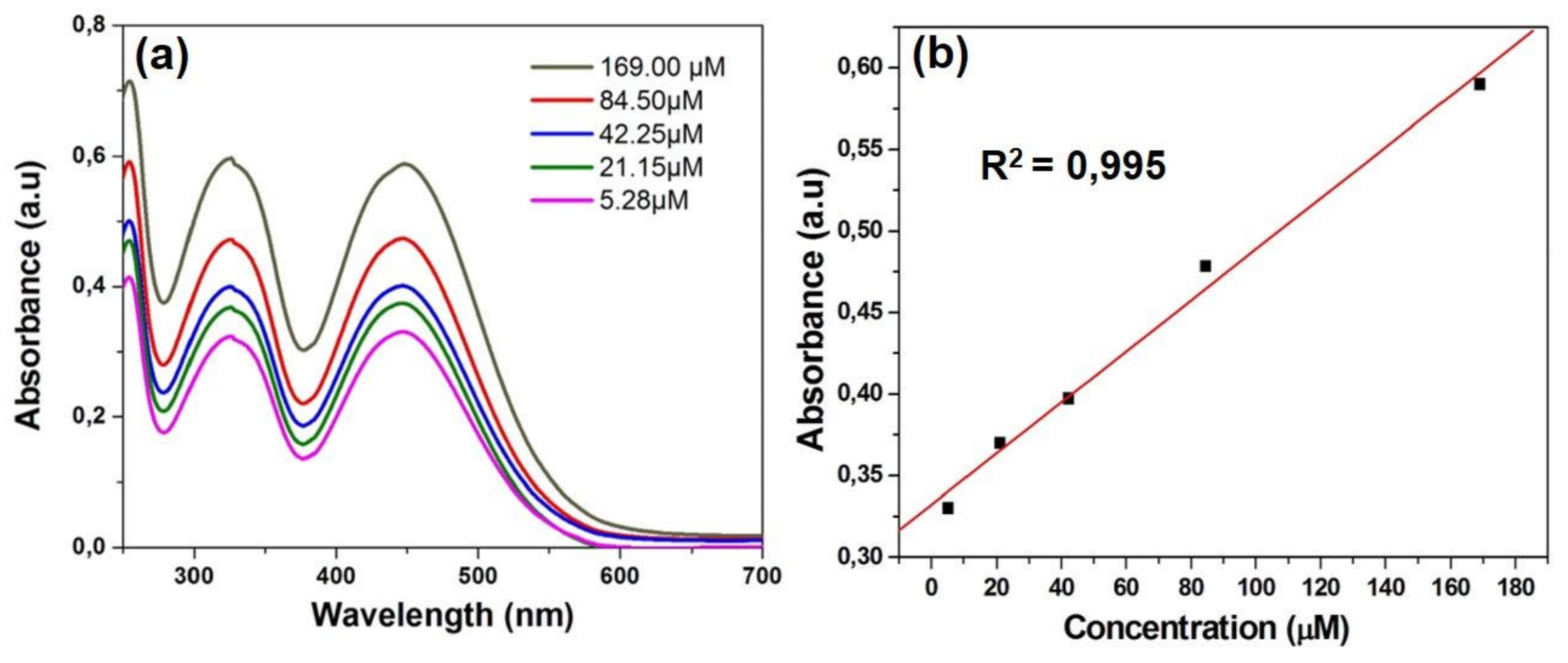



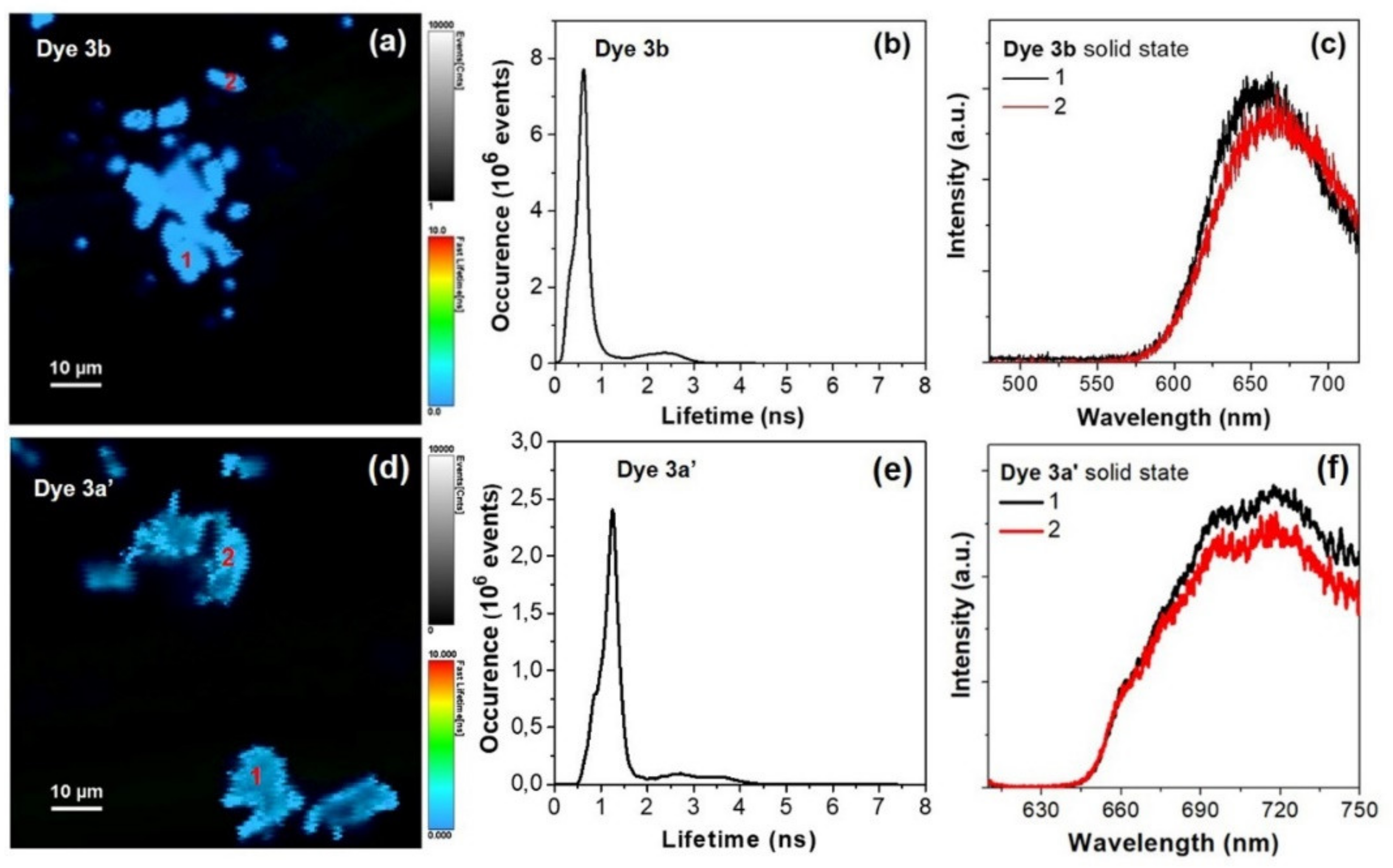

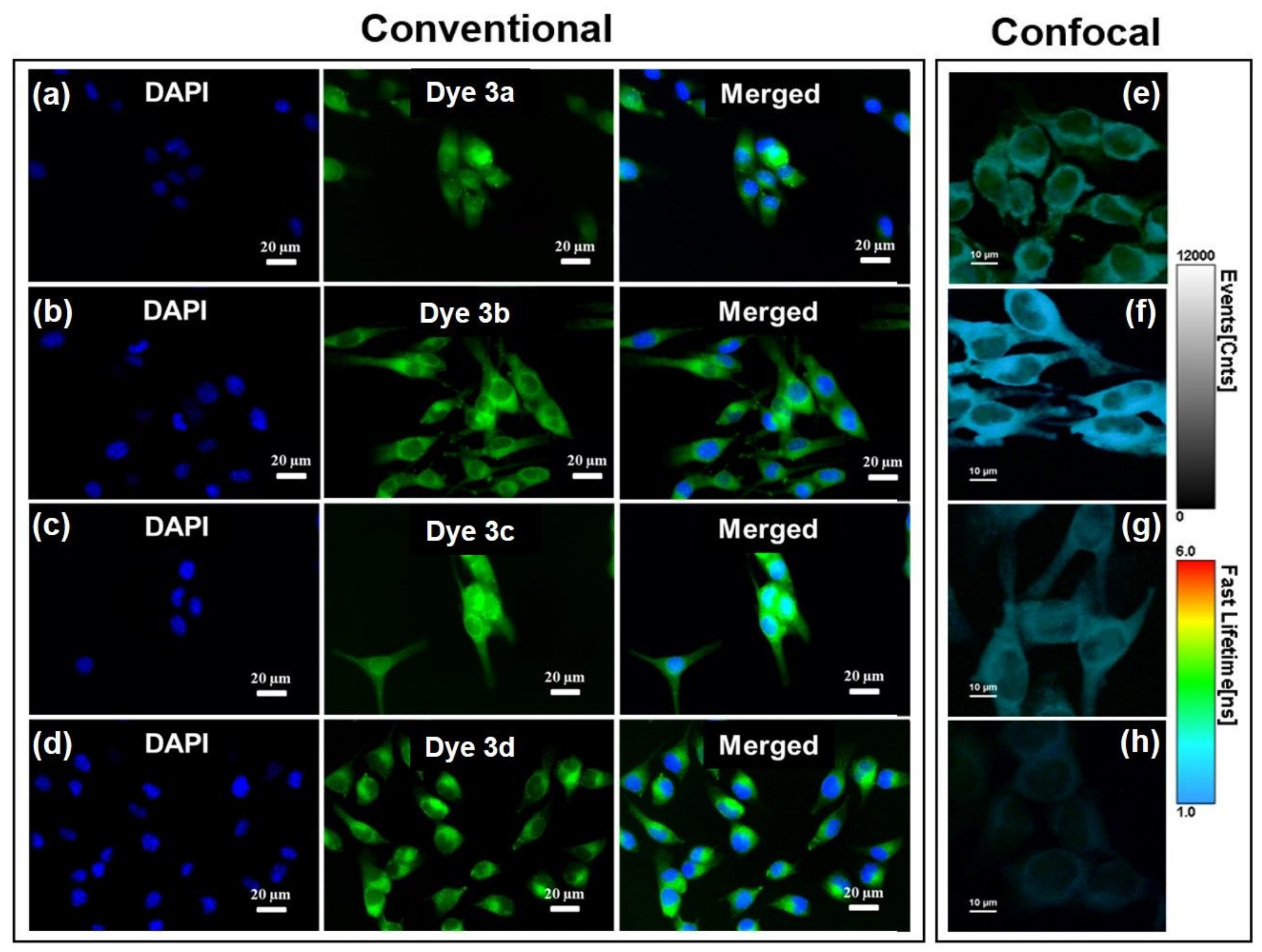
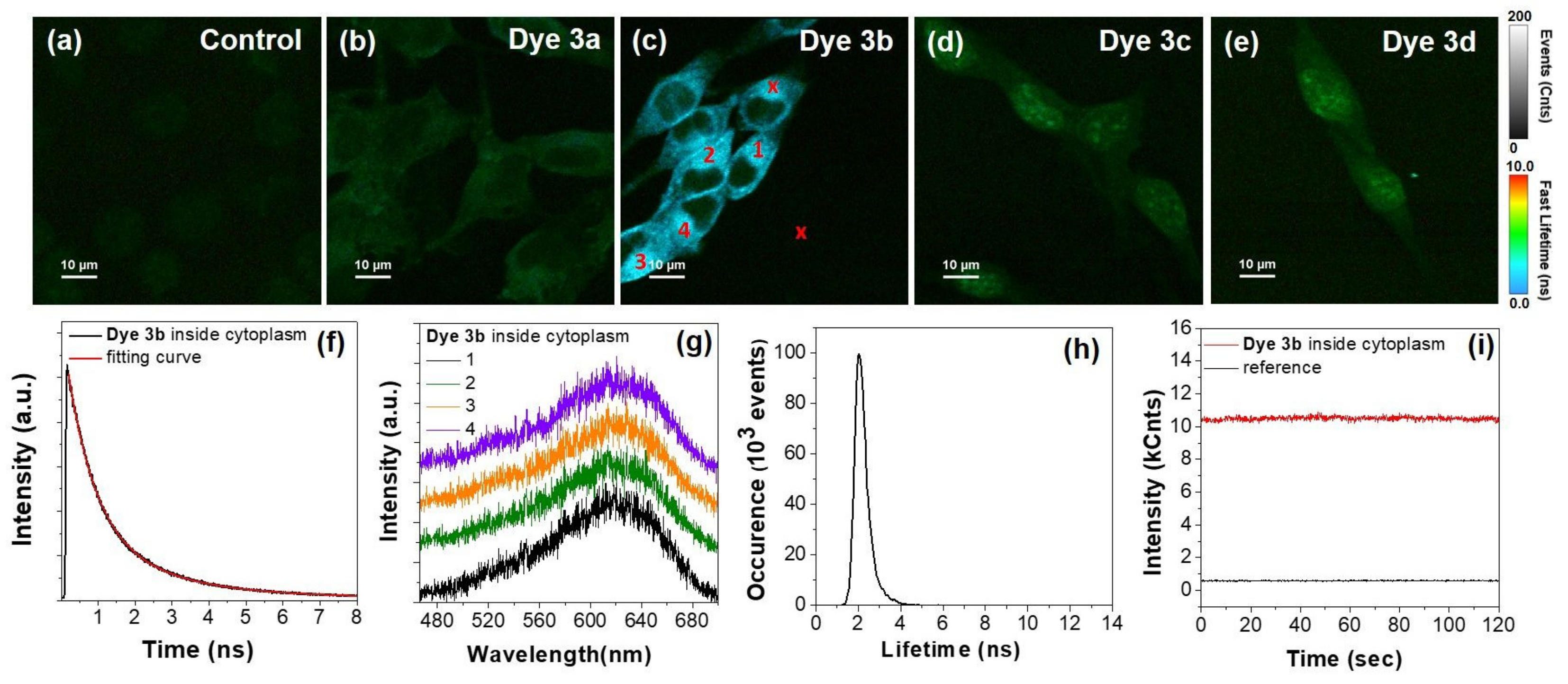

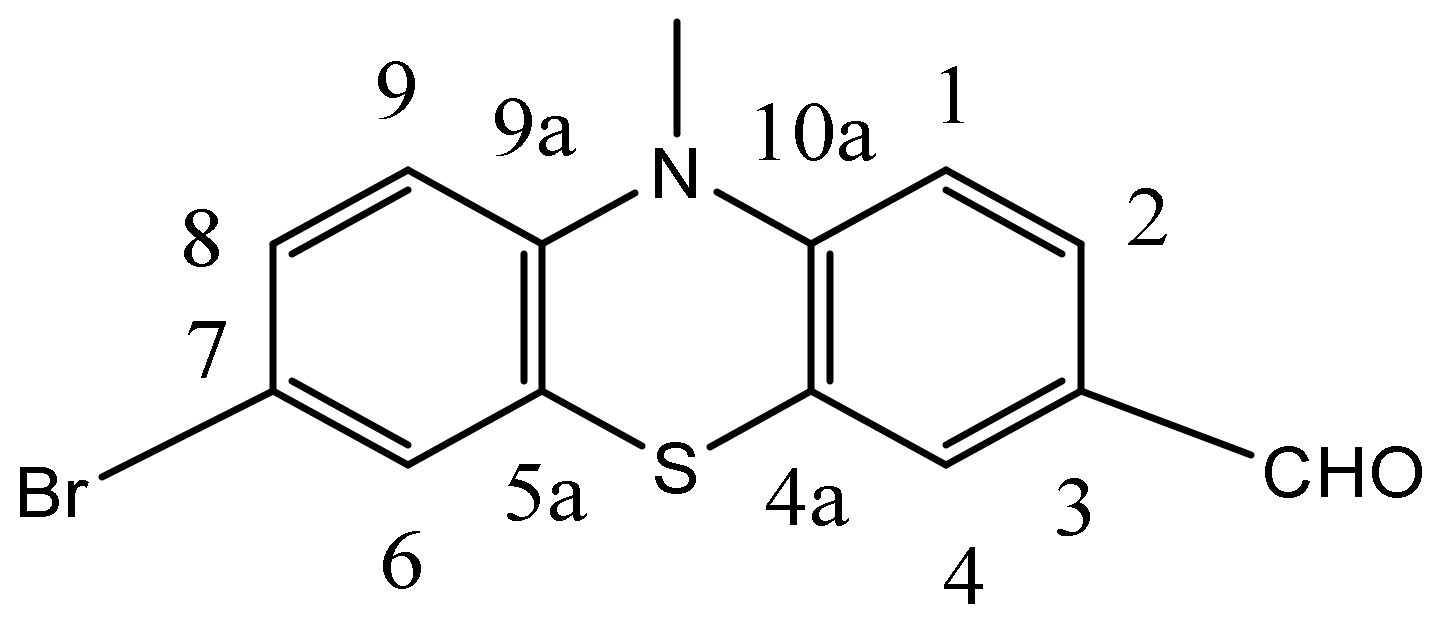

| Cpd. |  | λabs a | λem b | Stokes Shift | ||||
|---|---|---|---|---|---|---|---|---|
| R | R′ | R″ | X− | (nm) | (nm) | (cm−1) | Ref. | |
| 3a | H | –CH3 | –CH3 | I− | 455 | 749 | 8627 | [11] |
| 3a′ | H | –CH3 | –CH3 | BF4− | 455 | 720 (605 *) | 8089 | |
| 3b | Br | –C2H5 | –CH3 | I− | 460 | 650 | 6354 | |
| 3c | H | –CH3 | –C4H9 | I− | 458 | 669 | 6886 | [11] |
| 3d | H | –CH3 | –(CH2)3-Cl | Br− | 459 | 670 | 6861 | |
| Identification Code | Dye 3b |
|---|---|
| Empirical formula | C22H20BrIN2S |
| Formula weight | 551.27 |
| Temperature/K | 123.1 |
| Crystal system | Monoclinic |
| Space group | P21/c |
| a/Å | 17.6219(4) |
| b/Å | 7.8451(2) |
| c/Å | 15.0465(3) |
| α/° | 90 |
| β/° | 101.306(2) |
| γ/° | 90 |
| Volume/Å3 | 2039.75(8) |
| Z | 4 |
| ρcalcg/cm3 | 1.795 |
| μ/mm−1 | 15.650 |
| F (000) | 1080.0 |
| Crystal size/mm3 | 0.1 × 0.15 × 0.17 |
| Radiation | CuKα (λ = 1.54184) |
| 2Θ range for data collection/° | 10.238 to 141.238 |
| Index ranges | −21 ≤ h ≤ 19, −9 ≤ k ≤ 5, −18 ≤ l ≤ 18 |
| Reflections collected | 7087 |
| Independent reflections | 3843 [Rint = 0.0299, Rsigma = 0.0447] |
| Data/restraints/parameters | 3843/0/246 |
| Goodness-of-fit on F2 | 1.046 |
| Final R indexes [I > = 2σ (I)] | R1 = 0.0372, wR2 = 0.0961 |
| Final R indexes [all data] | R1 = 0.0453, wR2 = 0.1033 |
| Largest diff. peak/hole/e Å−3 | 1.11/−1.06 |
| Item | Samples | Expression | Calculated/ Reported Value |
|---|---|---|---|
| Quantum yield | Rhodamine 101 (Ethanol + 0.01% HCl) | Φst | 1 [26] |
| 3a′ (Chloroform sol.) | Φx | 0.035 | |
| Absorbance at 525 nm | Rhodamine 101 | Ast | 0.0265 |
| 3a′ | Ax | 0.07 | |
| Area of emission spectrum | Rhodamine 101 | Fst | 19327.82 |
| 3a′ | Fx | 16255.18 | |
| Average refractive index value of solvent | Rhodamine 101 | nst | 1.85423 |
| 3a′ | nx | 2.085 | |
| Dilution ratio | Rhodamine 101 | Dst | 102 |
| 3a′ | Dx | 103 |
| Dye | A | A′ | Log P |
|---|---|---|---|
| 3b | 0.535 | 0.088 | 0.748 |
| 3c | 0.453 | 0.080 | 0.711 |
Publisher’s Note: MDPI stays neutral with regard to jurisdictional claims in published maps and institutional affiliations. |
© 2021 by the authors. Licensee MDPI, Basel, Switzerland. This article is an open access article distributed under the terms and conditions of the Creative Commons Attribution (CC BY) license (http://creativecommons.org/licenses/by/4.0/).
Share and Cite
Stoean, B.; Rugina, D.; Focsan, M.; Craciun, A.-M.; Nistor, M.; Lovasz, T.; Turza, A.; Porumb, I.-D.; Gál, E.; Cristea, C.; et al. Novel (Phenothiazinyl)Vinyl-Pyridinium Dyes and Their Potential Applications as Cellular Staining Agents. Int. J. Mol. Sci. 2021, 22, 2985. https://doi.org/10.3390/ijms22062985
Stoean B, Rugina D, Focsan M, Craciun A-M, Nistor M, Lovasz T, Turza A, Porumb I-D, Gál E, Cristea C, et al. Novel (Phenothiazinyl)Vinyl-Pyridinium Dyes and Their Potential Applications as Cellular Staining Agents. International Journal of Molecular Sciences. 2021; 22(6):2985. https://doi.org/10.3390/ijms22062985
Chicago/Turabian StyleStoean, Bianca, Dumitrita Rugina, Monica Focsan, Ana-Maria Craciun, Mǎdǎlina Nistor, Tamas Lovasz, Alexandru Turza, Ioan-Dan Porumb, Emese Gál, Castelia Cristea, and et al. 2021. "Novel (Phenothiazinyl)Vinyl-Pyridinium Dyes and Their Potential Applications as Cellular Staining Agents" International Journal of Molecular Sciences 22, no. 6: 2985. https://doi.org/10.3390/ijms22062985
APA StyleStoean, B., Rugina, D., Focsan, M., Craciun, A.-M., Nistor, M., Lovasz, T., Turza, A., Porumb, I.-D., Gál, E., Cristea, C., Silaghi-Dumitrescu, L., Astilean, S., & Gaina, L. I. (2021). Novel (Phenothiazinyl)Vinyl-Pyridinium Dyes and Their Potential Applications as Cellular Staining Agents. International Journal of Molecular Sciences, 22(6), 2985. https://doi.org/10.3390/ijms22062985









